 |
| Due to weather one waits with plant growing until after Mother's Day. |
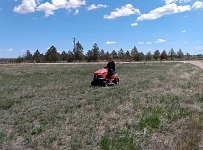 |
| At least Bryan fixed our mower. |
In ancient time of Sid's younger years, he spent one summer on a farm in Norway
— beyond the Arctic Circle. One of the most surprising was a discovery
that the locals were using every last minute of the six weeks of local summer
— and did not understand the urges of spoilt people from the south, to
SLEEP at least once in twenty-four hours. Here, in southern Wyoming, we are
located nearer the Tropic of Cancer than the Polar Circle — but thanks to
the altitude (we're higher here than most East Coast mountains) our vegetation
period shrinks into some twelve weeks. That's still twice as long than Norway
— and we have a regular night, thus our circadian rhythms don't interfere
with our need to sleep — but the pressure to accomplish everything at once
right now, is incredible.
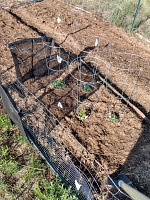 |
| Tomatoes are cold this year. |
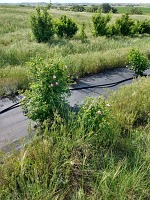 |
| Wild rose decided to go feral and sent an offshoot into the prairie. |
One is supposed to wait with planting vegetables until after Mother's Day
— the official brochure for the county even claims that last frost happens
on average on May 20 — thus there's not much time till first autumn frost
(average September 25) for things to grow, blossom, and yield fruit. Vegetation
is used to operate in this manner — before you finish sticking four tomato
seedlings into the ground, a three feet thistle sprouts up nearby. I was most
surprised by seedlings of honey locust — which I wrote off at the start of
April as dead — one by one they grew little leaves — but by what
system, I have no clue — trees planted six feet apart on the same day
easily sprouted leaves one month apart from each other. At the end of May I dare
to say that majority of the trees survived — which means success, since I
first thought that of twenty five seedlings, two or three lived.
Apparently, of the last year's twelve small firs, one did not make it —
I consider that permitted attrition — I've spotted cases in the
neighborhood where they had to throw away tens of frost-burnt trees.
Of two Austrian roses that I planted last year, one survived the winter —
and produced beautiful flowers. And since I am a lazy gardener and I failed to
dig out and throw away the dead one — it rewarded me by sprouting fresh
twigs from the stem. So it gets a second chance and we will see. Overall,
perhaps one must not be too hasty with gardening. Similarly, black currants came
to life, after I had written them off. An experimental micro-plot of wild
flowers, after two months of sulking, decided to bestow on us a variety of
wild blooms — even showing California orange poppies — so we have
a whiff of our old home.
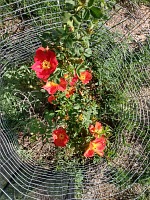 |
| Orange Austrian rose. |
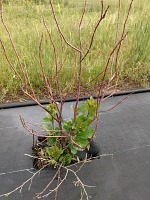 |
| Chokecherries did not give up, fixing last year's aphid damage. |
Roses and currants that I had planted in the form of twigs with bare roots, grew
after two years into massive bushes full of blossoms (and currant fruits —
we shall see if I manage to harvest anything before birds and other wild life
takes them). The roses, in multiple cases, decided to be truly wild and sent out
off-shoots out of ordered rows with landscape fabric and irrigation.
Chokecherries defied ants and aphids and grew some more, forming clusters of
small fruits. I'm especially pleased with that — for two summers I spent
in futile and therefor frustrating efforts to rescue these trees, which were
being liquidated above ground by aphids, and at roots below ground by ants.
I tried everything, soap water, diatomaceous earth, even chemical attacks like
borax or spraying — I surrendered to the plan to discard the dead trees
this year and plant something that aphids don't like. As a last resort of the
spring I fertilized the trees with coffee grinds — which should repel ants
— and either that helped, or the long winter and cold rainy spring —
but ants and aphids backed off the trees enough that the plants manged to
blossom and form fruits. (Aphids and ants came back in June, but I hope it will
be manageable).
I even experimented with pasting all trunks with an insect glue (ants and aphids
get won't get to the leaves, as they get stuck tu the trunk), but this obviously
is not a workable solution in my situation. Chokecherries are closer to bushes
than proper trees, and pasting a whole lot of tiny trunks or twigs is
unrealistic time-wise (given about fifty seedlings, each sporting three to five
shoots; that's several hundred trunks) — given an inch or so per trunk,
it's an incredible hassle... and crawling on the ground (bushes as still
relatively low) with a foil and jar of crazy sticky glue is more a slapstick
comedy material than an epic saga. Simply put, I had given up on this route.
In the end — I have managed to convince my amazed colleagues at work that
I'm collecting used coffee grinds from the machine not because I cannot afford
fresh coffee for myself, but because it's a legitimate gardening supplement.
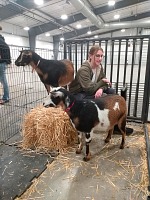 |
| Lori and Enya exhibit themselves at the exhibition. |
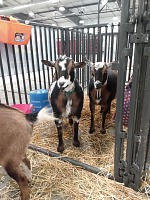 |
| Mick and Freddy are fearful and don't want to mingle. |
This year's wet spring has been very nice to all plants (perhaps with the
exception of tomatoes — they obviously don't enjoy cool days) — and
thus I consider it a lucky accident that we have finally found someone who was
able and willing to fix our mower. Bryan, a fellow balloonist, gradually put its
engine and transmissions back in order, sharpened and swapped blades — and
our resident mechanical engineer Tom got intrigued by the mower mechanism to the
point, where he's willing to mow our prairie. And buy more gasoline and swap
some belts etc. Thus our lot is mowed around the driveway and in front of the
house. We leave our pasture to the goats and the back side of the property
remains a native prairie. Which is, according to a learned brochure from our
county (and common sense), the correct approach. The prairie is all very well
arranged — it grows thin high grass, which protects the lower plants and
blossoms from wind, and the ground from excessive desiccation. Momentarily, One
cannot see for the grass, how much variety of blossoms and grasses grow here,
but every near look reveals a wide range of colors and shapes.
As I mentioned earlier, a part of our property is a fenced-off pasture, where
I don't reach with my gardening methods, leaving everything to goaties and
chickens. Now that the grass has grown high, we have a lot less expense for hay
and other feed — and in the and I have the impression that the animals
consume less water. Goaties have lost some heft — though it would be also
in part through shedding their two inches of winter cashmere sweaters.
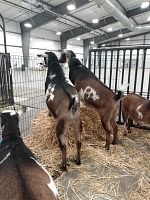 |
| Watching competition at the exhibition. |
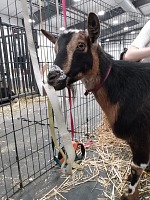 |
| Bonnie grasped the leash - she seems to want to go home. |
For the end of May, I promised my participation and voluntary help at a goat
exhibition — it's an unofficial event of
Wyoming Dairy Goat
Association — unofficial in results not being entered into federal
rosters, but otherwise they all take it very seriously. It's a kind of trial run
for everybody — for exhibitors and breeders, but mostly for their charges
— the goats, getting used to the whole circus — transport, stay in
a small pen in a strange place, presence of tens of other goats — and
orderly conduct on a leash in front of the judges.
I had originally promised to help with organization — as a person who
understands goats, is not scared of them and knows how to move among them, while
not burdened by being an exhibitor and having to take care of my own animals.
I felt that I could be quite useful that way. Than on the organizers suggested
to spice up the otherwise boring competition for the audiences — and make
goats available for the layman visitor to pet or groom, try to milk, maybe
cuddle with little baby goats. I don't currently have baby or lactating goats
— but what if I brought my cute dwarf goaties for the petting and
grooming?
I took time off my work and on Saturday morning the children and I loaded our
"kids" — well, they're all two years old and thus adult —
leaving Licorice and Twilight at home (especially the latter truly is not a good
representative of nice and civilized goat) — and with much crazy bleating
and crying, set out to the fairgrounds — which is fortunately located on
a nearby hill, i.e. some ten minutes drive from our house. A rodeo ensued there
with dragging five resisting goats into their assigned pen. Tom and Lisa wanted
to give it up, but I persisted — mostly because I think it is necessary
for our goats to get out of their one shed and their one pen they know, into the
world. They should get used to being transported and staying in a different
place. And walking on a leash — we applied leashes at home a week before
the show, but obviously not enough — judged by the circus they'd made
there.
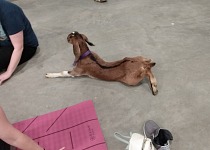 |
| Some baby goats take goat yoga very literally. |
 |
| In the whirl of all my ranching, Lisa managed to graduate from high school. |
Eventually we got them all into the proper pen, but it took perhaps an hour
before at least the girls (Bonnie, Enya and Lori) stopped shaking and began to
look around a little and notice their surroundings. I was taken aback how the
big and strong boys — Mick and Freddy — remained hiding in a corner
and were most frightened — only in the afternoon then could lie down and
relax for a while. Girls enjoyed attention from the audience, let themselves be
petted and groomed, and generally seemed to understand what was expected of
them. Lori made a goat exhibit and installed herself on a straw bail so that
people could reach her even across the barrier, thus being properly able to
admire her.
A show goatie became a surprise, for she looked exactly like Loreena —
one could see that our goats were not quite sure how Lori managed to double
herself. Another interesting observation was that our goats altogether ignored
all other breeds — but were quite captivated whenever another Nigerian
dwarf goat occurred nearby. And when Nigerian bucks came to play, everybody was
beside themselves. By three in the afternoon we all have had enough —
and gladly headed home — with a greater help and less of a circus we were
able to conclude that the event went well — everybody lived. And not just
that — it seems that our presence got appreciated by everybody —
we expected the audience to enjoy a spot where they can talk to breeders and
cuddle a baby goat or with their own hands try milking, or even just pet a goat.
I was happy with breeders themselves praising our participation — as
during the competition they had scarce time to chat with people and entertain
little children — and were glad to rely on a middleman between the serious
show and enthusiastic layman public.
 |
| At Lisa's graduation ceremony. |
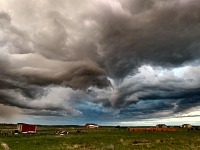 |
| Weather remains April-like. |
On Sunday I went back solo to the fairground as originally planned, i.e. without
my goaties. I was supposed to help with the organization and checking, when was
each goats' and owners' turn to appear in the exhibit arena. It turned out they
did not need me there, and so I went to check out the
rodeo
goat yoga. It was a new feature of the event, and small discrepancies surfaced
in its organization. A yoga class would certainly be possible to take place
just in one corner in the huge hall — but not including about fifteen baby
goats of various age. The youngest one participated in their role with no
difficulty — they simply made beds on the warm laps of their admirers, and
quietly slept through the class. Somewhat older baby goats had a completely
different idea about what to do inside a whole ninety minutes of freedom in a
huge hall — hence I spent the whole time chasing baby goats. Although I
got back home before noon that day, I was still sweating and tired like after
the Saturday's whole-day rodeo.
Perhaps I shall have to journey to Norway and find out, why they don't need to
sleep in summer there — if I did not sleep, I would possibly have managed
all the above stuff much better.


















